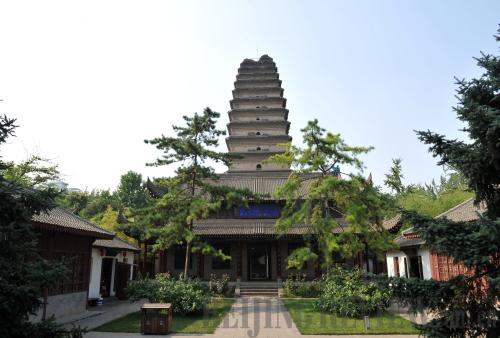|
 |
|
STANDING STILL: The Small Goose Pagoda in Xi'an, capital of northwest China's Shaanxi Province, built in 707 during the Tang Dynasty, is one of the 22 Silk Road relics located in China (XINHUA) |
The long-lost trade route that connected China with civilizations throughout Central Asia and Europe from the second century B.C. to the 16th century, the Silk Road, is now being restored to its former glory.
On June 22, during the 38th session of the World Heritage Committee, the trail entitled Silk Roads: the Routes Network of Chang'an-Tianshan Corridor was added to its list of World Heritage Sites. The session, held this year in Doha, Qatar, is an annual UNESCO event designed to continually update its list of unique cultural wonders. During this year's event, a total of 26 new sites were added to the list, bringing the number of World Heritage Sites to 1,007 across 161 countries.
According to UNESCO's World Heritage Committee, the Silk Road had, at the height of its 2,000-year-long usage, brought together numerous civilizations and "facilitated far-reaching exchanges in the activities of trade, religious beliefs, scientific knowledge, technological innovation, cultural practices and the arts."
The Silk Road was pioneered by ancient Chinese imperial envoy Zhang Qian (164-114 B.C.). In the more than 1,000 years that followed, it became a major trade route connecting the Middle Kingdom with multiple empires throughout Central Asia and stretching as far west as the east coast of the Mediterranean Sea in Europe. After a new maritime route from Western Europe to East Asia was opened in the late 15th century, though, the Silk Road gradually fell into decline. However, it played a vital role in promoting prosperity and cultural exchanges between both Eastern and Western civilizations in early history. Today, most countries along the old route have worked diligently to preserve Silk Road relics.
The Silk Road is the first site submitted to the World Heritage Committee in the form of a joint application from multiple countries, said Tong Mingkang, Deputy Director of the Chinese State Administration of Cultural Heritage. Additionally, it is the first time China has worked together with Kazakhstan and Kyrgyzstan to promote a cross-border site.
The Silk Road, as recorded on the list, includes 33 temples, mountain passes, relics, and more in a vast road network that stretches some 8,700 km across China, Kazakhstan and Kyrgyzstan, the first of which is home to 22 of the historic sites. Kazakhstan holds eight, while three are in Kyrgyzstan.
Cross-border cooperation
"We have made great efforts in these past few years with our partners to get the Silk Road added to the World Heritage List. The international cooperation of our three countries is unprecedented and remarkable," Tong said.
"The Silk Road provides a successful model for China to emulate in the future regarding international cooperation for the protection of cultural relics with other countries," said Chen Tongbin, Director of the Institute of Architectural History under the China Architecture Design and Research Group. She is an expert on the joint work team for the Silk Road.
A decades-long dream of preservation was achieved with the success of the 2014 Silk Road bid. As early as 1988, UNESCO began researching and assessing Silk Road heritage sites. The organization then carried out five international surveys in China and central Asian countries in the following decade.
In 2006, the Chinese Government first began the work of applying for a spot for the Silk Road on the World Heritage Sites list. The next year, China was joined by five Central Asian countries—Kazakhstan, Kyrgyzstan, Tajikistan, Uzbekistan and Turkmenistan—and the countries reached an agreement on jointly lobbying for the international route to be inscribed on the roster.
"At the beginning, no one knew how to prepare documents and plans for a cross-border heritage site," said Chen. "The Silk Road is a very long network of routes involving many countries. The application work was so complicated that it was delayed year after year and got behind schedule."
"The entire Silk Road from China to Italy is 10,000 km long, tracing its way through more than 20 countries," noted Chen. "We found it impossible to put the whole Silk Road into one package."
|
